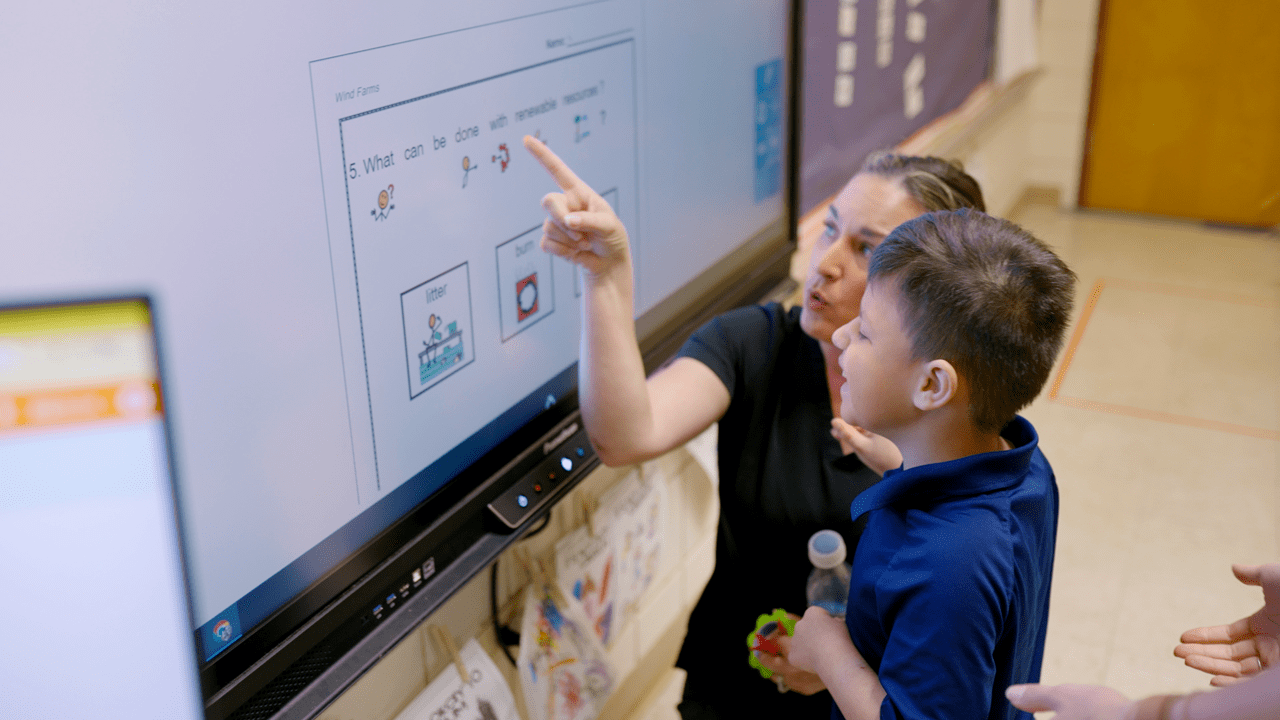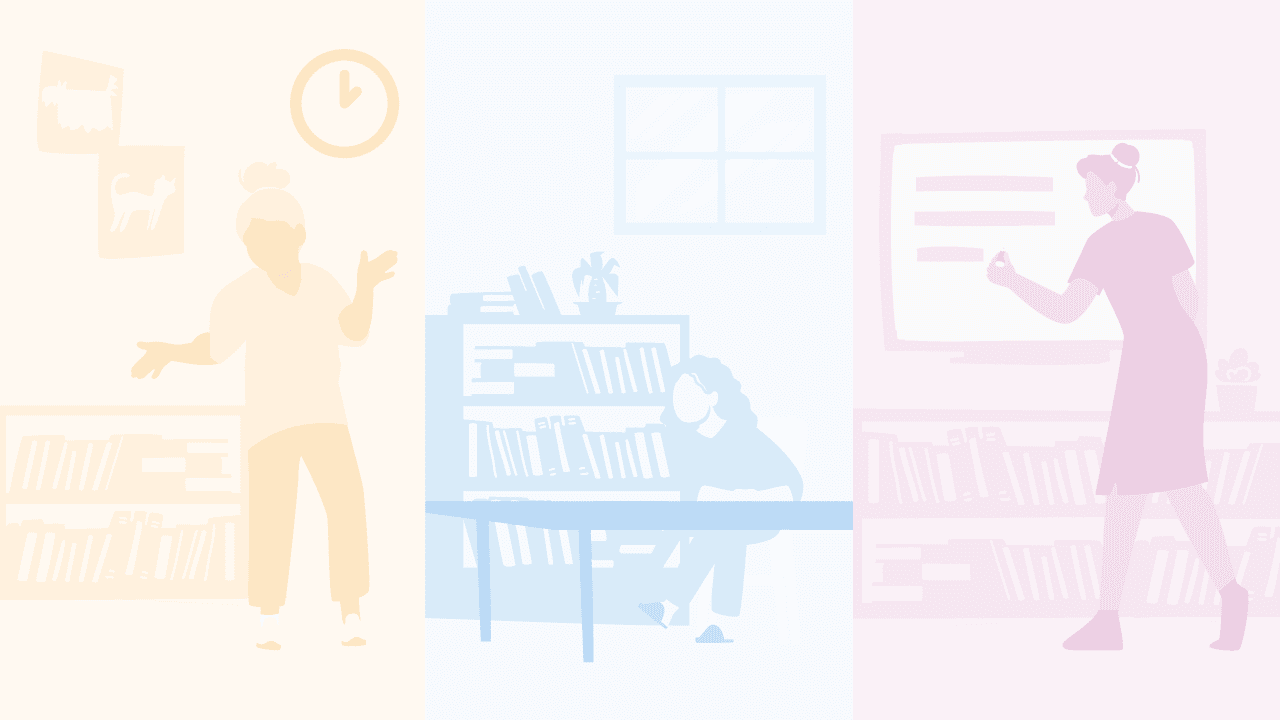Regardless of the model in use, teachers can always incorporate evidence‑based practices such as visual supports and social narratives to help our students understand new and very different rules, routines, and instructional norms. Visual supports include specific types of visual cues that give the learner additional concrete information about the expectations, activity, or skills being taught. Social narratives are an evidence‑based strategy used for clarifying social or behavioral rules while also giving the learner information about others’ perspectives.
The following suggestions are designed to help teachers incorporate these practices in order to promote student understanding and success, no matter what the learning environment may be.
Remote Learning Practices and Strategies
If you are teaching in a fully remote capacity, the use of visual supports and social narratives will necessarily look different, primarily because many of them will be presented on a screen rather than on paper. However, because this type of instruction might be new for most of your students (even if they had some initial exposure before), these practices will be critical in helping clarify expectations. Here are simple supports that can be helpful when presenting instruction or information virtually.
Use social narratives to explain why remote learning is occurring and what the experience and daily routine will be like. You can even email a copy to parents to review with their students. Start your online sessions by reviewing the narrative and repeat it daily until they all understand the new school routine and the reasons for it. As is the case with all social narratives, write in first person from the students’ perspective and make sure the wording matches the developmental level of your students. Incorporate photos or pictures to increase their understanding.
Use a visual schedule or checklist to explain each day’s routine. Start virtual sessions by visually presenting what will happen throughout the day. Remember to keep visual schedules and checklists at the appropriate cognitive and receptive language level of your students, with photos or pictures supporting their understanding as needed.

Include visual cues and instructions to highlight key details and information you are presenting. Think about how best to draw a student’s attention to the most relevant information on the screen. In person, teachers are able to use gestures and prompts to do this, but during remote instruction, color‑coding and highlighting may help direct them. You can also use virtual pointers or highlighters as you are teaching. Finally, you may want to consider presenting less information on the screen to keep your instruction clear and concise.
Incorporate a student’s high interests into instructional activities and remote learning to better hold their attention and engage them in instruction they might otherwise find challenging. Think of fun and unique ways to capitalize on their interests when teaching difficult concepts. For example, if a student loves trains, consider using them to teach counting or color identification.
Hybrid or In-Person Learning
Supporting students’ understanding of health safety measures
Teachers working in a hybrid instructional model or in person are likely to face the challenges of helping students understand social distancing, hand washing, and wearing masks in response to COVID‑19. Here are practices and supports that can be used to help explain expectations related to health safety measures at school.
Use social narratives to present new school expectations. Write in concise language that matches the developmental level of your students, adding photos or pictures to clarify and increase understanding.

Once you have introduced rules or expectations with social narratives, provide your students with visual cues or reminders about the rules. Have them on hand as students are moving through the school or when interacting with others. Make sure that the reminders are concise and match the developmental and language level of your students.

In-Person Learning in the Total School Environment
Finally, it’s important that those who are teaching in person use evidence‑based practices and strategies throughout the total school environment. Below are some practical suggestions that easily can be incorporated into some of the most challenging environments at school for many of our students.
Supporting students at recess
Recess can often be difficult due to its unstructured nature and high social demands. For some students, recess is not a time to relax and play, but rather a time that evokes anxiety and frustration. This can be even more likely to occur when they are given new and more stringent rules related to health concerns, such as COVID‑19.
Teach playground rules through the use of social narratives and then pair the narrative with aligned visual reminders about those expectations. These should be easily accessible to share with your students as needed on the playground.

Provide a visual checklist of exactly what your students should do during recess. Often students with autism and other complex learning challenges don’t understand what to do during “free” time. A checklist provides needed guidance about what options are appropriate and acceptable during recess. These options may include independent or shared activities with peers.
Use visual supports such as a token system to give students a way to count repetitions of activities such as turns on the slide, laps around the track, or turns kicking the soccer ball. You may also want to provide a visual turn‑taking system (i.e., my turn/your turn) and label a specific “waiting area” to help clarify when it is time to take a turn playing a game and when it is time to sit and wait.

Finally, provide both instruction and visual cues to aid your student in understanding how to ask for a break when things feel overwhelming or to ask for help when needed.
Supporting students in specials or inclusion classes (art, music, PE)
Similar to recess, specials and inclusion classes can be challenging for students because they are often less naturally structured than the main academic classroom environment. These classes can also include increased sensory input, which may lead students to feel overstimulated. Additionally, specials or inclusion classes may not occur every day, so the lack of consistency in the routine may be confusing to students. The following strategies and practices can often help ease stress and increase student engagement.
Use a visual weekly calendar and daily schedule to support your students’ understanding of what to expect throughout the week and each day. Make sure they include the appropriate level of support (i.e., objects, photos, pictures, or words) and are presented in a way that makes the most sense to your students.

Use a visual checklist or activity system to let them know what to expect in each class. If needed, provide a highly reinforcing activity at the end of the checklist so they learn a “first work, then play” routine.
Teach classroom rules and expectations by using social narratives and then provide supporting visual reminders that highlight those rules as needed throughout the class.
Supporting students at lunch
Lunch and going to the cafeteria can be a challenging time due to the many distractions and sensory stimuli. However, it can also be an excellent opportunity to practice communication and social skills and to increase independence and self‑advocacy skills. Using visual supports can help students know what to expect and can help facilitate communication skills such as choice-making and requesting.
Use visual choice boards to help students make appropriate lunch choices. Choices can be presented using objects, photos, or pictures. Make sure that the number of items presented at one time matches the developmental level of your student. Determine when choices should best be made (i.e., in the classroom right before lunch) and how the student will present those choices to make requests to the cafeteria staff once they are in the cafeteria.
Increase student independence and social skills by providing visual supports to help with saying hello to the cafeteria staff, checking out, and paying for lunch.
Help students who eat quickly with “waiting” by creating a wait bag or choice board with simple handheld or sensory items.
Use visual reminders to remind students of rules and expectations like throwing away trash, using a napkin, and staying in their seats.

Supporting students in assemblies, field trips, and safety drills
Finally, help promote student success by providing instruction and visual supports for students during assemblies, field trips, and safety drills. All of these changes to the typical school routine can result in confusion and stress because they bring unexpected changes to the schedule.
Prepare students as much as possible for a change that will be occurring within the visual schedule. Schedule changes can be hard, so provide as much context and notice as would make sense to each particular student. Make sure the schedule reflects the change as clearly as possible. If the change is to something less preferred (like a safety drill), you may want to show that once the change concludes, they will be able to participate in more highly preferred reinforcement or activity.
You may also want to introduce the change with a social narrative explaining why the change is occurring and how it will impact them.
Provide a visual checklist or way for them to see what will take place. Make sure to include each step so there is no confusion and, if needed, provide a way for them to observe that they are making progress through the checklist by turning over cards, flipping to the next page, or putting the cards into a finished pocket.

If possible, provide both instruction and visual cues to aid your student in being able to ask for a break when things feel overwhelming.
Though special education may look different among various districts, utilizing evidence‑based practices such as visual supports and social narratives will be critical to help students better understand instructional norms and meet their annual goals. Whether you are teaching remotely, in a hybrid model, or in person, effective teaching strategies can be implemented to ensure student success.



